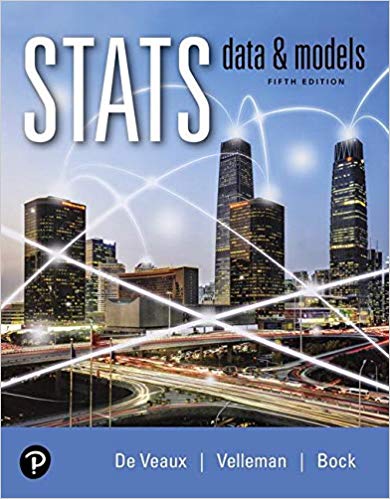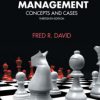Test Bank for Stats Data and Models 5th by De Veaux
$55.00 Original price was: $55.00.$29.99Current price is: $29.99.
Test Bank for Stats Data and Models 5th by De Veaux
This is completed downloadable of Test Bank for Stats Data and Models 5th by De Veaux.

Instant download Test Bank for Stats Data and Models 5th by De Veaux pdf docx epub after payment.
Product Details:
- ISBN-10 : 013516382X
- ISBN-13 : 978-0135163825
- Author: Richard D. De Veaux; Paul F. Velleman; David E. Bock
Encourages statistical thinking using technology, innovative methods, and a sense of humor
Inspired by the 2016 GAISE Report revision, Stats: Data and Models, 5th Edition by De Veaux/Velleman/Bock uses innovative strategies to help students think critically about data ― while maintaining the book’s core concepts, coverage, and most importantly, readability.
By using technology and simulations to demonstrate variability at critical points throughout the course, the authors make it easier for instructors to teach and for students to understand more complicated statistical concepts later in the course (such as the Central Limit Theorem). In addition, students get more exposure to large data sets and multivariate thinking, which better prepares them to be critical consumers of statistics in the 21st century.
The 5th Edition’s approach to teaching Stats: Data and Models is revolutionary, yet it retains the book’s lively tone and hallmark pedagogical features such as its Think/Show/Tell Step-by-Step Examples.
Table Of Contents:
I: EXPLORING AND UNDERSTANDING DATA
- Stats Starts Here
- 1.1 What Is Statistics?
- 1.2 Data
- 1.3 Variables
- 1.4 Models
- Displaying and Describing Data
- 2.1 Summarizing and Displaying a Categorical Variable
- 2.2 Displaying a Quantitative Variable
- 2.3 Shape
- 2.4 Center
- 2.5 Spread
- Relationships Between Categorical Variables–Contingency Tables
- 3.1 Contingency Tables
- 3.2 Conditional Distributions
- 3.3 Displaying Contingency Tables
- 3.4 Three Categorical Variables
- Understanding and Comparing Distributions
- 4.1 Displays for Comparing Groups
- 4.2 Outliers
- 4.3 Re-Expressing Data: A First Look
- The Standard Deviation as a Ruler and the Normal Model
- 5.1 Using the Standard Deviation to Standardize Values
- 5.2 Shifting and Scaling
- 5.3 Normal Models
- 5.4 Working with Normal Percentiles
- 5.5 Normal Probability Plots
- Review of Part I: Exploring and Understanding Data
II. EXPLORING RELATIONSHIPS BETWEEN VARIABLES
- Scatterplots, Association, and Correlation
- 6.1 Scatterplots
- 6.2 Correlation
- 6.3 Warning: Correlation ≠ Causation
- *6.4 Straightening Scatterplots
- Linear Regression
- 7.1 Least Squares: The Line of “Best Fit”
- 7.2 The Linear Model
- 7.3 Finding the Least Squares Line
- 7.4 Regression to the Mean
- 7.5 Examining the Residuals
- 7.6 R2–The Variation Accounted for by the Model
- 7.7 Regression Assumptions and Conditions
- Regression Wisdom
- 8.1 Examining Residuals
- 8.2 Extrapolation: Reaching Beyond the Data
- 8.3 Outliers, Leverage, and Influence
- 8.4 Lurking Variables and Causation
- 8.5 Working with Summary Values
- *8.6 Straightening Scatterplots–The Three Goals
- *8.7 Finding a Good Re-Expression
- Multiple Regression
- 9.1 What Is Multiple Regression?
- 9.2 Interpreting Multiple Regression Coefficients
- 9.3 The Multiple Regression Model–Assumptions and Conditions
- 9.4 Partial Regression Plots
- *9.5 Indicator Variables
- Review of Part II: Exploring Relationships Between Variables
III. GATHERING DATA
- Sample Surveys
- 10.1 The Three Big Ideas of Sampling
- 10.2 Populations and Parameters
- 10.3 Simple Random Samples
- 10.4 Other Sampling Designs
- 10.5 From the Population to the Sample: You Can’t Always Get What You Want
- 10.6 The Valid Survey
- 10.7 Common Sampling Mistakes, or How to Sample Badly
- Experiments and Observational Studies
- 11.1 Observational Studies
- 11.2 Randomized, Comparative Experiments
- 11.3 The Four Principles of Experimental Design
- 11.4 Control Groups
- 11.5 Blocking
- 11.6 Confounding
- Review of Part III: Gathering Data
IV. RANDOMNESS AND PROBABILITY
- From Randomness to Probability
- 12.1 Random Phenomena
- 12.2 Modeling Probability
- 12.3 Formal Probability
- Probability Rules!
- 13.1 The General Addition Rule
- 13.2 Conditional Probability and the General Multiplication Rule
- 13.3 Independence
- 13.4 Picturing Probability: Tables, Venn Diagrams, and Trees
- 13.5 Reversing the Conditioning and Bayes’ Rule
- Random Variables
- 14.1 Center: The Expected Value
- 14.2 Spread: The Standard Deviation
- 14.3 Shifting and Combining Random Variables
- 14.4 Continuous Random Variables
- Probability Models
- 15.1 Bernoulli Trials
- 15.2 The Geometric Model
- 15.3 The Binomial Model
- 15.4 Approximating the Binomial with a Normal Model
- 15.5 The Continuity Correction
- 15.6 The Poisson Model
- 15.7 Other Continuous Random Variables: The Uniform and the Exponential
- Review of Part IV: Randomness and Probability
V. INFERENCE FOR ONE PARAMETER
- Sampling Distribution Models and Confidence Intervals for Proportions
- 16.1 The Sampling Distribution Model for a Proportion
- 16.2 When Does the Normal Model Work? Assumptions and Conditions
- 16.3 A Confidence Interval for a Proportion
- 16.4 Interpreting Confidence Intervals: What Does 95% Confidence Really Mean?
- 16.5 Margin of Error: Certainty vs. Precision
- *16.6 Choosing the Sample Size
- Confidence Intervals for Means
- 17.1 The Central Limit Theorem
- 17.2 A Confidence Interval for the Mean
- 17.3 Interpreting Confidence Intervals
- *17.4 Picking Our Interval up by Our Bootstraps
- 17.5 Thoughts About Confidence Intervals
- Testing Hypotheses
- 18.1 Hypotheses
- 18.2 P-Values
- 18.3 The Reasoning of Hypothesis Testing
- 18.4 A Hypothesis Test for the Mean
- 18.5 Intervals and Tests
- 18.6 P-Values and Decisions: What to Tell About a Hypothesis Test
- More About Tests and Intervals
- 19.1 Interpreting P-Values
- 19.2 Alpha Levels and Critical Values
- 19.3 Practical vs. Statistical Significance
- 19.4 Errors
- Review of Part V: Inference for One Parameter
VI. INFERENCE FOR RELATIONSHIPS
- Comparing Groups
- 20.1 A Confidence Interval for the Difference Between Two Proportions
- 20.2 Assumptions and Conditions for Comparing Proportions
- 20.3 The Two-Sample z-Test: Testing for the Difference Between Proportions
- 20.4 A Confidence Interval for the Difference Between Two Means
- 20.5 The Two-Sample t-Test: Testing for the Difference Between Two Means
- *20.6 Randomization Tests and Confidence Intervals for Two Means
- *20.7 Pooling
- *20.8 The Standard Deviation of a Difference
- Paired Samples and Blocks
- 21.1 Paired Data
- 21.2 The Paired t-Test
- 21.3 Confidence Intervals for Matched Pairs
- 21.4 Blocking
- Comparing Counts
- 22.1 Goodness-of-Fit Tests
- 22.2 Chi-Square Test of Homogeneity
- 22.3 Examining the Residuals
- 22.4 Chi-Square Test of Independence
- Inferences for Regression
- 23.1 The Regression Model
- 23.2 Assumptions and Conditions
- 23.3 Regression Inference and Intuition
- 23.4 The Regression Table
- 23.5 Multiple Regression Inference
- 23.6 Confidence and Prediction Intervals
- *23.7 Logistic Regression
- *23.8 More About Regression
- Review of Part VI: Inference for Relationships
VII. INFERENCE WHEN VARIABLES ARE RELATED
- Multiple Regression Wisdom
- 24.1 Multiple Regression Inference
- 24.2 Comparing Multiple Regression Model
- 24.3 Indicators
- 24.4 Diagnosing Regression Models: Looking at the Cases
- 24.5 Building Multiple Regression Models
- Analysis of Variance
- 25.1 Testing Whether the Means of Several Groups Are Equal
- 25.2 The ANOVA Table
- 25.3 Assumptions and Conditions
- 25.4 Comparing Means
- 25.5 ANOVA on Observational Data
- Multifactor Analysis of Variance
- 26.1 A Two Factor ANOVA Model
- 26.2 Assumptions and Conditions
- 26.3 Interactions
- Statistics and Data Science
- 27.1 Introduction to Data Mining
- Review of Part VII: Inference When Variables Are Related
People also search:
stats data and models 5th edition pdf
stats data and models by de veaux velleman and bock
stats data and models 5th edition pdf answer key
Related products
Test Bank
Test Bank for Decision Support and Business Intelligence Systems, 9th Edition: Efraim Turban











